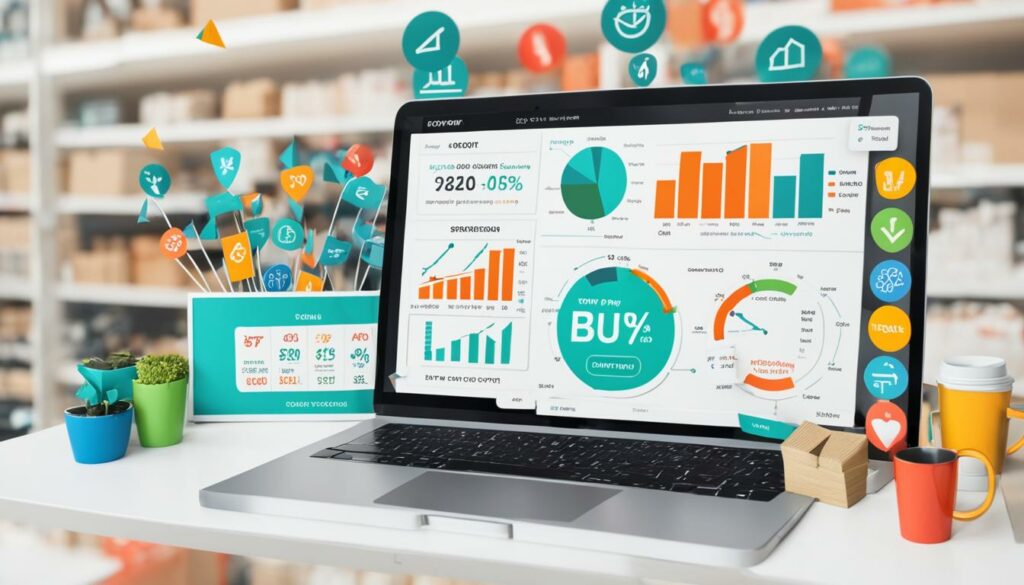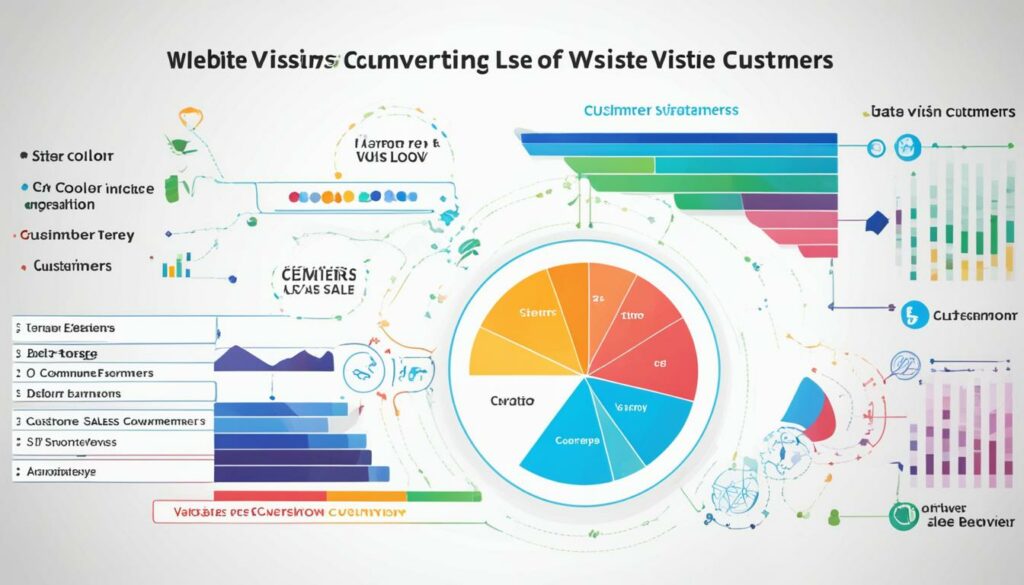Conversion is a crucial metric for ecommerce organizations to measure their return on investment (ROI) and gauge the success of their online stores. In the context of ecommerce, conversion refers to the percentage of website visitors who complete a desired action, such as making a purchase, adding items to a cart or wishlist, or signing up for emails. It is a fundamental indicator of customer engagement and the effectiveness of marketing efforts.
Conversion rate optimization (CRO) plays a vital role in driving specific key performance indicators (KPIs), especially sales. By improving the user experience and making it easier for visitors to take the desired actions, ecommerce businesses can enhance their conversion rates and increase their revenue. Therefore, understanding conversion strategies and implementing them effectively is critical for achieving ecommerce success.
To accurately measure conversions, it is important to collect data and analyze various metrics. Some key metrics include bounce rate, which indicates the percentage of visitors who leave the website after viewing only one page; exit rate, which measures the percentage of visitors who leave the website from a specific page; click-through rate, which measures the number of people who click on a link to the website from an ad or email; average session duration, which measures how long visitors stay on the website; and average page depth, which tracks the number of pages viewed per session. These metrics provide valuable insights into user engagement, website performance, and areas that need improvement to optimize conversion rates.
Key Takeaways:
- Conversion is the percentage of website visitors who complete a desired action, such as making a purchase or signing up for emails.
- Conversion rate optimization (CRO) focuses on improving the user experience to drive specific KPIs, especially sales.
- Key metrics for measuring conversions include bounce rate, exit rate, click-through rate, average session duration, and average page depth.
- Tools like HotJar, Quantcast Measure, Google Analytics, and BigCommerce Analytics provide valuable insights and analytics to help improve ecommerce conversion rates.
- Understanding customer behavior, analyzing the customer journey, and personalizing the shopping experience can enhance customer engagement and increase conversions.
Understanding Ecommerce Conversion Rates
Ecommerce conversion rates are a critical measure of success for online stores. These rates indicate the percentage of website visitors who complete a desired action, such as making a purchase or taking another predefined action. To optimize conversion rates, businesses implement conversion rate optimization (CRO) strategies that focus on improving the shopping experience and driving key performance indicators (KPIs), typically sales.
Before diving into CRO initiatives, it is crucial to establish benchmarks and analyze current visitor behavior. By understanding existing conversion rates and visitor patterns, businesses can identify areas for improvement and set realistic goals. On average, ecommerce conversion rates range from 2.5% to 3%, with a benchmark goal of achieving a conversion rate of 3% or higher.
Measuring conversion rates alone is not sufficient. It is important to monitor and analyze other relevant metrics like bounce rate, exit rate, click-through rate, average session duration, and average page depth. These metrics provide valuable insights into user engagement, website navigation, and overall performance, all of which contribute to conversion rates.
Key Metrics for Measuring Ecommerce Conversions:
| Metric | Definition |
|---|---|
| Bounce Rate | The percentage of visitors who leave a website after viewing a single page |
| Exit Rate | The percentage of visitors who leave the website from a specific page |
| Click-Through Rate | The number of people who click a link to the website from an ad or email |
| Average Session Duration | The average time visitors spend on the website |
| Average Page Depth | The average number of pages viewed per session |
By continually improving these metrics, businesses can enhance user experience, website design, and call-to-action buttons to drive higher conversion rates. Testing different strategies, implementing user-friendly navigation, and optimizing checkout processes are some tactics that can significantly impact conversion rates. Additionally, providing comprehensive product information, optimizing website performance, and leveraging social proof can also contribute to improved conversions.
Understanding ecommerce conversion rates and implementing effective conversion rate optimization strategies is a crucial component of a successful online business. By continuously monitoring and optimizing these rates, ecommerce businesses can increase revenue, drive growth, and ultimately enhance the overall customer experience.
Strategies to Improve Ecommerce Conversion Rates
Improving ecommerce conversion rates is a key objective for businesses looking to optimize their online sales. By implementing the right strategies, you can enhance ecommerce conversion rates and maximize your revenue. Here are some effective tactics:
-
Optimize User Experience: A seamless and user-friendly website design is essential for improving ecommerce conversion rates. Ensure that your website is easy to navigate, has fast load times, and is mobile-responsive. By providing a positive user experience, you can reduce friction and encourage visitors to convert.
-
A/B Testing: A/B testing involves comparing two versions of a web page or element to determine which performs better in terms of conversion. By testing different variations of your website design, call-to-action buttons, and other elements, you can identify what resonates best with your audience and optimize for higher conversions.
-
Create Compelling Call-to-Action Buttons: A well-designed and persuasive call-to-action (CTA) button can significantly impact conversion rates. Use clear and action-oriented language, such as “Shop Now,” “Add to Cart,” or “Sign Up Today.” Experiment with different button colors, sizes, and placements to find the optimal combination that drives conversions.
-
Provide Clear Product Information: High-quality product descriptions, images, and videos are crucial for building trust and reducing any uncertainties that potential customers may have. Ensure that your product details are comprehensive, accurate, and highlight the benefits and unique selling points. This will not only enhance the user experience but also increase the likelihood of conversions.
-
Streamline the Checkout Process: A complicated and lengthy checkout process can lead to cart abandonment. Simplify the steps required to complete a purchase, minimize form fields, and offer guest checkout options. Additionally, provide multiple payment and shipping options to cater to different customer preferences.
-
Personalize the Shopping Experience: Tailoring the shopping experience to individual users can significantly improve conversion rates. Utilize data from previous interactions to offer personalized recommendations, product suggestions, and targeted promotions. By showing customers relevant content based on their preferences and browsing history, you can increase engagement and encourage conversions.
Implementing these strategies can help you improve ecommerce conversion rates and unlock the full potential of your online business. By continuously analyzing data, conducting A/B tests, and refining your website design and user experience, you can drive higher conversions and achieve greater success in the competitive ecommerce landscape.

Quote:
“Optimizing ecommerce conversion rates is a continuous process of experimentation, analysis, and refinement. By implementing effective strategies and keeping a user-centric approach, businesses can drive better conversions and increase their bottom line.” – Jane Smith, Ecommerce Consultant
Customer Behavior and Conversion
Understanding customer behavior is crucial for improving ecommerce conversion rates. By analyzing customer behavior, businesses can identify pain points, optimize the user experience, and ultimately increase conversions.
The customer journey plays a significant role in the conversion process. It encompasses the steps from getting interested in a product to making a purchase. Analyzing the customer journey provides valuable insights into how visitors interact with the website and what influences their decision-making.
One powerful tool for analyzing customer behavior is Google Analytics. This platform enables businesses to track the paths visitors take on the website, identify drop-off points, and gather relevant data for analysis. By understanding the specific actions customers take before converting, companies can pinpoint areas where improvements can be made.
Factors Influencing Customer Behavior and Conversion Rates
- Page Load Time: Slow-loading websites can frustrate customers and lead to high bounce rates. Optimizing the website’s speed is crucial for ensuring a positive user experience and minimizing customer abandonment.
- Site Navigation: Intuitive and easy-to-use navigation is essential for guiding customers through the website and helping them find what they’re looking for. Clear menus, search functions, and well-organized categories contribute to a seamless browsing experience.
- Product Descriptions: Engaging and informative product descriptions are influential in convincing customers to make a purchase. Compelling copy that highlights the key features, benefits, and unique selling points of a product can greatly impact conversion rates.
- Social Proof: Customer reviews, testimonials, and ratings can provide social proof that instills trust in potential buyers. Positive feedback from satisfied customers can influence purchasing decisions and increase conversions.
- Checkout Process: A seamless and user-friendly checkout process is critical for reducing cart abandonment. Simplifying the steps required to complete a purchase, offering guest checkout options, and providing multiple payment methods can all contribute to higher conversion rates.
Another effective strategy for improving customer behavior and increasing conversions is personalization. By tailoring the shopping experience based on user preferences and demographics, businesses can enhance customer engagement and satisfaction.
Utilizing data analysis to understand customer behavior and implementing optimization strategies based on these insights is key to driving higher conversion rates in ecommerce.

Conversion in Relation to Other Ecommerce Metrics
When it comes to measuring the success of an ecommerce business, conversion is closely intertwined with other key metrics that provide valuable insights into user engagement, navigation, and overall website performance. Let’s explore how these metrics, including bounce rate, exit rate, click-through rate, average session duration, and average page depth, impact conversion rates and contribute to overall ecommerce success.
Bounce Rate
Bounce rate refers to the percentage of visitors who leave a website after viewing only a single page. A high bounce rate indicates that visitors are not engaging with the website beyond their initial landing page, which can negatively affect conversion rates. By improving the relevancy and appeal of landing pages, businesses can reduce bounce rates and increase the likelihood of capturing visitors’ interest and converting them into customers.
Exit Rate
Exit rate measures the percentage of visitors who leave the website from a specific page. Unlike bounce rate, exit rate takes into account visitors who have interacted with multiple pages before leaving. High exit rates on certain pages may indicate a need for improvement, such as optimizing the content, user experience, or call-to-action elements. This can help guide visitors towards completing desired actions and ultimately improve conversion rates.
Click-through Rate
Click-through rate (CTR) is the number of people who click a link to the website from an ad or email. It provides insights into the effectiveness of marketing campaigns and the ability to attract visitors to the website. A high CTR indicates that the ad or email is compelling and resonates with the target audience. By optimizing marketing materials and ensuring the alignment between the message and the landing page, businesses can increase the likelihood of converting visitors into customers.
Average Session Duration
Average session duration measures how long visitors stay on the website. A longer average session duration indicates that visitors are actively engaging with the content and exploring multiple pages. This metric is particularly valuable as it signifies a higher level of interest and potential for conversion. By providing engaging content, improving website navigation, and streamlining the user experience, businesses can extend the duration of visitor sessions and increase the chances of conversion.
Average Page Depth
Average page depth tracks the number of pages viewed per session. It indicates the level of interest and engagement a visitor has with the website. A higher average page depth suggests that visitors are actively exploring the website and consuming more content, which can lead to higher conversion rates. By optimizing internal linking, improving site navigation, and providing relevant and engaging content throughout the website, businesses can increase average page depth and enhance the overall user experience.
Improving these metrics can contribute to higher conversion rates and overall ecommerce success. By analyzing and optimizing these key performance indicators, businesses can gain valuable insights into user behavior, identify areas for improvement, and create a website experience that maximizes conversions.
Challenges and Considerations for Ecommerce Conversion
When it comes to increasing ecommerce conversion rates, there are several challenges and considerations that businesses must address. One common challenge is cart abandonment. Many customers add items to their carts but never complete the purchase. To combat this, it is important to address hidden costs and be transparent about pricing. By clearly displaying all costs upfront and offering free shipping or discounts, you can alleviate any concerns customers may have and increase the likelihood of conversion.
Another crucial aspect of improving ecommerce conversion is effective copywriting and product descriptions. By investing in persuasive and engaging copy, you can build trust with your customers and provide them with all the relevant information they need to make a purchasing decision. Clear and concise descriptions, along with compelling product images, can help customers understand the value of your products and increase the chances of conversion.
Creating a sense of scarcity and urgency is another strategy that can significantly impact conversion rates. Limited edition products or time-limited offers can create a fear of missing out and encourage customers to make a purchase. By leveraging scarcity and urgency effectively, you can create a sense of exclusivity and drive customer action.
Lastly, offering live chat support can greatly improve the overall shopping experience and address any concerns or questions customers may have. By providing immediate assistance and resolving queries in real-time, you can instill confidence in your customers and increase their likelihood of conversion. Live chat support also allows you to gather valuable insights and feedback from customers, enabling you to continually optimize your website and improve conversions.
FAQ
What is conversion in ecommerce?
Conversion in ecommerce refers to the percentage of website visitors who complete a desired action, such as making a purchase or signing up for emails.
How can conversion rates be improved in ecommerce?
There are several strategies to improve ecommerce conversion rates, including optimizing the user experience, personalizing the shopping experience, and analyzing customer behavior.
What is conversion rate optimization (CRO) in ecommerce?
Conversion rate optimization (CRO) is the process of improving the user experience on a website to drive specific key performance indicators (KPIs), particularly sales.
What are some tactics to improve ecommerce conversion rates?
Some effective tactics to improve ecommerce conversion rates include optimizing website design, using A/B testing, improving call-to-action buttons, and providing personalized recommendations.
How can customer behavior impact conversion rates in ecommerce?
Analyzing customer behavior, such as the customer journey and data analysis, can help identify pain points and optimize the user experience to improve conversion rates.
How does conversion relate to other ecommerce metrics?
Conversion is closely related to metrics such as bounce rate, exit rate, click-through rate, average session duration, and average page depth, which provide insights into user engagement and website performance.
What are some common challenges in ecommerce conversion?
Common challenges in ecommerce conversion include cart abandonment, hidden costs, ineffective copywriting, and the need for live chat support.
